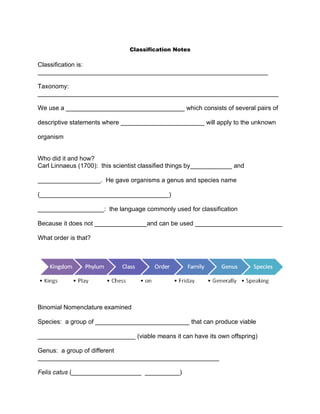
Classification notes blank revised
- 1. Classification Notes Classification is: __________________________________________________________________ Taxonomy: _____________________________________________________________________ We use a __________________________________ which consists of several pairs of descriptive statements where ________________________ will apply to the unknown organism Who did it and how? Carl Linnaeus (1700): this scientist classified things by____________ and __________________. He gave organisms a genus and species name (_____________________________________) ___________________: the language commonly used for classification Because it does not _______________and can be used _________________________ What order is that? Binomial Nomenclature examined Species: a group of ___________________________ that can produce viable ____________________________ (viable means it can have its own offspring) Genus: a group of different ____________________________________________________ Felis catus (____________________ __________)
- 2. Six kingdoms Two ___________________________ kingdoms: •Archaebacteria •Eubacteria Four __________________________ kingdoms: •Protist •Plantae •Fungi •Animalia Archeabacteria & Eubateria Both are _____________________ with No _____________________ (______________________________) Archaebacteria can live where most organisms could not survive (deep ocean vents, hot spring) ______________________________ make up most of ____________ kinds of bacteria on earth. Example: E. coli, Hot springs algae Protists • ________________________________________________________________ ______________ • have a _______________________ • ___________________________ and _________________________________ Example: euglena, paramecium, slime molds Fungi • __________________________ and _____________________________ • __________________________________ (obtains energy from other source) Example: mushrooms, yeasts, molds
- 3. Animals • ________________________________________________________________ • heterotrophs- ______________________________________________ • have _______________________, ______________________, ________________________ • Most ______________ Plants • ___________________________or ______________________________ with a __________________________________________________ • have a _______________________________ • _________________________________- makes own food • (________________________) Example: sequoia, flowers The Plant Kingdom: A quick overview Plants are multicellular Plants make their own food (_________________________________) 2 main groups Plants are either ________________________ or _______________________________ Nonvascular • Nonvascular plants have no ______________________________________________ _________________________________________________ ____________. • They rely on ________________________________and __________________________. • They have _____ true ________________, _____________________ or _______________.
- 4. • They are ______________. Nonvascular Examples are mosses and liverworts Vascular plants • Have tissues or pipes to ____________________________water • _________________________, ___________________ and __________________ There are 2 types of vascular plants 1. those that ________________________________ 2. those that _________________________________________ Seedless vascular plants Examples are ferns, club mosses and horsetails. Vascular plant with seeds The vascular plants with seeds are divided into 2 categories: 1. ____________________________________ 2. ____________________________________ Non-flowering seeded plants Called _____________________________________________ Examples are _______________________________ (trees that produce cones) and ginko trees Flowering seeded plants Called __________________________________ Examples are corn, tulips, water lilies, peach trees, magnolia trees, grass, palm trees, cactus, cotton plants and much more!
- 5. Now, let’s see what you remember… What are the 2 main groups of plants? Answer: ___________________________________ ___________________________________ Which of these two groups includes plants that are large and have pipes to carry water? Answer: _______________________________________________ Is a moss vascular or nonvascular? Answer: _______________________________________________________________ What are the 2 main groups of vascular plants? Answer: ____________________________________________________________________ Are pine trees gymnosperms or angiosperms? Answer: ______________________________________________________________________ Which one is not an angiosperm? Water lily Tomato plant Cactus Fern Palm tree Corn Tulip Answer: Only the fern is seedless and non-flowering.
